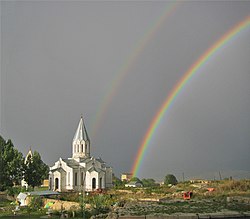

The following outline is provided as an overview and topical guide of the Republic of Artsakh and Nagorno-Karabakh region:
Contents
- General reference
- Geography of Artsakh
- Regions of Artsakh
- Demography of Artsakh
- Government and politics of Artsakh
- Executive branch of the government of Artsakh
- Legislative branch of the government of Artsakh
- Foreign relations of Artsakh
- Law and order in Artsakh
- Military of Artsakh
- History of Artsakh
- Culture of Artsakh
- Economy and infrastructure of Artsakh
- See also
- References
- External links
Nagorno-Karabakh is a disputed region in the South Caucasus region of Eurasia. It encompasses the former Republic of Artsakh, which was a de facto independent republic, and was de jure part of the Republic of Azerbaijan, [1] about 270 kilometers (170 mi) west of the Azerbaijani capital of Baku and neighbouring Armenia. [2]










